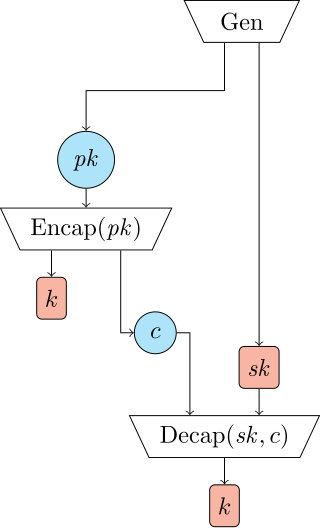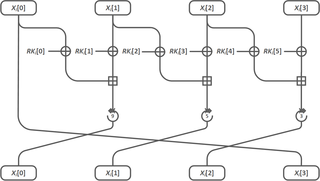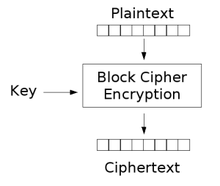RSA (Rivest–Shamir–Adleman) is a public-key cryptosystem, one of the oldest widely used for secure data transmission. The initialism "RSA" comes from the surnames of Ron Rivest, Adi Shamir and Leonard Adleman, who publicly described the algorithm in 1977. An equivalent system was developed secretly in 1973 at Government Communications Headquarters (GCHQ), the British signals intelligence agency, by the English mathematician Clifford Cocks. That system was declassified in 1997.
In cryptography, the ElGamal encryption system is an asymmetric key encryption algorithm for public-key cryptography which is based on the Diffie–Hellman key exchange. It was described by Taher Elgamal in 1985. ElGamal encryption is used in the free GNU Privacy Guard software, recent versions of PGP, and other cryptosystems. The Digital Signature Algorithm (DSA) is a variant of the ElGamal signature scheme, which should not be confused with ElGamal encryption.
Identity-based encryption (IBE), is an important primitive of identity-based cryptography. As such it is a type of public-key encryption in which the public key of a user is some unique information about the identity of the user. This means that a sender who has access to the public parameters of the system can encrypt a message using e.g. the text-value of the receiver's name or email address as a key. The receiver obtains its decryption key from a central authority, which needs to be trusted as it generates secret keys for every user.
In cryptography, a semantically secure cryptosystem is one where only negligible information about the plaintext can be feasibly extracted from the ciphertext. Specifically, any probabilistic, polynomial-time algorithm (PPTA) that is given the ciphertext of a certain message , and the message's length, cannot determine any partial information on the message with probability non-negligibly higher than all other PPTA's that only have access to the message length. This concept is the computational complexity analogue to Shannon's concept of perfect secrecy. Perfect secrecy means that the ciphertext reveals no information at all about the plaintext, whereas semantic security implies that any information revealed cannot be feasibly extracted.
Ciphertext indistinguishability is a property of many encryption schemes. Intuitively, if a cryptosystem possesses the property of indistinguishability, then an adversary will be unable to distinguish pairs of ciphertexts based on the message they encrypt. The property of indistinguishability under chosen plaintext attack is considered a basic requirement for most provably secure public key cryptosystems, though some schemes also provide indistinguishability under chosen ciphertext attack and adaptive chosen ciphertext attack. Indistinguishability under chosen plaintext attack is equivalent to the property of semantic security, and many cryptographic proofs use these definitions interchangeably.
The Goldwasser–Micali (GM) cryptosystem is an asymmetric key encryption algorithm developed by Shafi Goldwasser and Silvio Micali in 1982. GM has the distinction of being the first probabilistic public-key encryption scheme which is provably secure under standard cryptographic assumptions. However, it is not an efficient cryptosystem, as ciphertexts may be several hundred times larger than the initial plaintext. To prove the security properties of the cryptosystem, Goldwasser and Micali proposed the widely used definition of semantic security.
Integrated Encryption Scheme (IES) is a hybrid encryption scheme which provides semantic security against an adversary who is able to use chosen-plaintext or chosen-ciphertext attacks. The security of the scheme is based on the computational Diffie–Hellman problem.
Two variants of IES are specified: Discrete Logarithm Integrated Encryption Scheme (DLIES) and Elliptic Curve Integrated Encryption Scheme (ECIES), which is also known as the Elliptic Curve Augmented Encryption Scheme or simply the Elliptic Curve Encryption Scheme. These two variants are identical up to the change of an underlying group.
Homomorphic encryption is a form of encryption that allows computations to be performed on encrypted data without first having to decrypt it. The resulting computations are left in an encrypted form which, when decrypted, result in an output that is identical to that produced had the operations been performed on the unencrypted data. Homomorphic encryption can be used for privacy-preserving outsourced storage and computation. This allows data to be encrypted and outsourced to commercial cloud environments for processing, all while encrypted.
In computational complexity theory, a computational hardness assumption is the hypothesis that a particular problem cannot be solved efficiently. It is not known how to prove (unconditional) hardness for essentially any useful problem. Instead, computer scientists rely on reductions to formally relate the hardness of a new or complicated problem to a computational hardness assumption about a problem that is better-understood.

In cryptography, a key encapsulation mechanism, or KEM, is a public-key cryptosystem that allows a sender to generate a short secret key and transmit it to a receiver securely, in spite of eavesdropping and intercepting adversaries. Modern standards for public-key encryption of arbitrary messages are usually based on KEMs.
ACE is the collection of units, implementing both a public key encryption scheme and a digital signature scheme. Corresponding names for these schemes — «ACE Encrypt» and «ACE Sign». Schemes are based on Cramer-Shoup public key encryption scheme and Cramer-Shoup signature scheme. Introduced variants of these schemes are intended to achieve a good balance between performance and security of the whole encryption system.
Verifiable computing enables a computer to offload the computation of some function, to other perhaps untrusted clients, while maintaining verifiable results. The other clients evaluate the function and return the result with a proof that the computation of the function was carried out correctly. The introduction of this notion came as a result of the increasingly common phenomenon of "outsourcing" computation to untrusted users in projects such as SETI@home and also to the growing desire to enable computationally-weak devices to outsource computational tasks to a more powerful computation service, as in cloud computing. The concept dates back to work by Babai et al., and has been studied under various terms, including "checking computations", "delegating computations", "certified computation", and verifiable computing. The term verifiable computing itself was formalized by Rosario Gennaro, Craig Gentry, and Bryan Parno, and echoes Micali's "certified computation".
Attribute-based encryption is a generalisation of public-key encryption which enables fine grained access control of encrypted data using authorisation policies. The secret key of a user and the ciphertext are dependent upon attributes. In such a system, the decryption of a ciphertext is possible only if the set of attributes of the user key matches the attributes of the ciphertext.
The Sakai–Kasahara scheme, also known as the Sakai–Kasahara key encryption algorithm (SAKKE), is an identity-based encryption (IBE) system proposed by Ryuichi Sakai and Masao Kasahara in 2003. Alongside the Boneh–Franklin scheme, this is one of a small number of commercially implemented identity-based encryption schemes. It is an application of pairings over elliptic curves and finite fields. A security proof for the algorithm was produced in 2005 by Chen and Cheng. SAKKE is described in Internet Engineering Task Force (IETF) RFC 6508.

Amit Sahai is an Indian-American computer scientist. He is a professor of computer science at UCLA and the director of the Center for Encrypted Functionalities.
Garbled circuit is a cryptographic protocol that enables two-party secure computation in which two mistrusting parties can jointly evaluate a function over their private inputs without the presence of a trusted third party. In the garbled circuit protocol, the function has to be described as a Boolean circuit.
In cryptography, indistinguishability obfuscation is a type of software obfuscation with the defining property that obfuscating any two programs that compute the same mathematical function results in programs that cannot be distinguished from each other. Informally, such obfuscation hides the implementation of a program while still allowing users to run it. Formally, iO satisfies the property that obfuscations of two circuits of the same size which implement the same function are computationally indistinguishable.
HEAAN is an open source homomorphic encryption (HE) library which implements an approximate HE scheme proposed by Cheon, Kim, Kim and Song (CKKS). The first version of HEAAN was published on GitHub on 15 May 2016, and later a new version of HEAAN with a bootstrapping algorithm was released. Currently, the latest version is Version 2.1.
Brent R. Waters is an American computer scientist, specializing in cryptography and computer security. He is currently a professor of Computer Science at the University of Texas at Austin.

The Lightweight Encryption Algorithm is a 128-bit block cipher developed by South Korea in 2013 to provide confidentiality in high-speed environments such as big data and cloud computing, as well as lightweight environments such as IoT devices and mobile devices. LEA has three different key lengths: 128, 192, and 256 bits. LEA encrypts data about 1.5 to 2 times faster than AES, the most widely used block cipher in various software environments.



















